
A perak is a headdress typically worn by the old aristocracy in the Himalayan Ladakh region of Asia. It is composed of a strap of leather studded with semi-precious stones, such as lapis lazuli and turquoise.

A perak is a headdress typically worn by the old aristocracy in the Himalayan Ladakh region of Asia. It is composed of a strap of leather studded with semi-precious stones, such as lapis lazuli and turquoise.
The perak is a symbol among the Ladakh of the rank and economic status of the woman wearing it. [1] Traditionally, the number of front-to-back rows of turquoise signified the status of the wearer: nine rows for the queen of Leh (the Ladakh capital), seven rows for the more modern aristocracy, five for the marvels, and three for the lower ranks.
The jewels themselves are representative of the Ladakh deities, protecting and guiding the wearer through the dangerous human world.
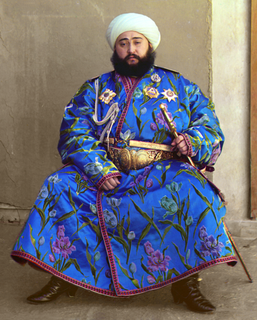
A turban is a type of headwear based on cloth winding. Featuring many variations, it is worn as customary headwear by people of various cultures. Communities with prominent turban-wearing traditions can be found in the Indian subcontinent, Southeast Asia, the Arabian Peninsula, the Middle East, the Balkans, the Caucasus, Central Asia, North Africa, West Africa, East Africa, and amongst some Turkic peoples in Russia as well as Ashkenazi Jews.

The fez, also called tarboosh, is a felt headdress in the shape of a short cylindrical peakless hat, usually red, and sometimes with a tassel attached to the top. The name "Fez" refers to the Moroccan city of Fez, where the dye to colour the hat was extracted from crimson berries. The modern fez owes much of its popularity to the Ottoman era.

Bunad is a Norwegian umbrella term encompassing, in its broadest sense, a range of both traditional rural clothes as well as modern 20th-century folk costumes. In its narrow sense the word bunad refers only to clothes designed in the early 20th century that are loosely based on traditional costumes. The word bunad in itself is a 20th-century invention.

War bonnets are feathered headgear traditionally worn by male leaders of the American Plains Indians Nations who have earned a place of great respect in their tribe. Originally they were sometimes worn into battle, but they are now primarily used for ceremonial occasions. In the Native American and First Nations communities that traditionally have these items of regalia, they are seen as items of great spiritual and political importance, only to be worn by those who have earned the right and honour through formal recognition by their people.

The hennin was a headdress in the shape of a cone, steeple, or truncated cone worn in the late Middle Ages by European women of the nobility. They were most common in Burgundy and France, but also elsewhere, especially at the English courts, and in Northern Europe, Hungary and Poland. They are little seen in Italy. It is unclear what styles the word hennin described at the time, though it is recorded as being used in French in 1428, probably before the conical style appeared. The word does not appear in English until the 19th century. The term is therefore used by some writers on costume for other female head-dresses of the period.

A Chaperon was a form of hood or, later, highly versatile hat worn in all parts of Western Europe in the Middle Ages. Initially a utilitarian garment, it first grew a long partly decorative tail behind called a liripipe, and then developed into a complex, versatile and expensive headgear after what was originally the vertical opening for the face began to be used as a horizontal opening for the head. It was especially fashionable in mid-15th century Burgundy, before gradually falling out of fashion in the late 15th century and returning to its utilitarian status. It is the most commonly worn male headgear in Early Netherlandish painting, but its complicated construction is often misunderstood.

The kokoshnik is a traditional Russian headdress worn by women and girls to accompany the sarafan. The kokoshnik tradition has existed since the 10th century in the ancient Russian city Veliky Novgorod. It spread primarily in the northern regions of Russia and was very popular from 16th to 19th century. It is still to this day an important feature of Russian dance ensembles and folk culture and inspired the Kokoshnik style of architecture.

Fashion in 15th-century Europe was characterized by a series of extremes and extravagances, from the voluminous robes called houppelandes with their sweeping floor-length sleeves to the revealing doublets and hose of Renaissance Italy. Hats, hoods, and other headdresses assumed increasing importance, and were draped, jewelled, and feathered.

Aztec clothing are the fiber of clothing that were worn by the Aztecs peoples during their time that varied based on aspects such as social standing and gender. The garments worn by Aztec peoples were also worn by other pre-Columbian peoples of central Mexico who shared similar cultural characteristics. The strict sumptuary laws present in Aztec society had dictated the type of fiber and ornamentation present in clothing, as well as how that clothing was worn based on class. Clothing and cloth were immensely significant in the culture.
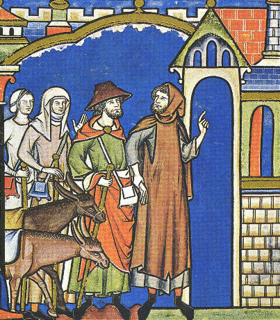
Costume during the thirteenth century in Europe was very simple for both men and women, and quite uniform across the continent. Male and female clothing were relatively similar, and changed very slowly, if at all. Most clothing, especially outside the wealthier classes, remained little changed from three or four centuries earlier. The century saw great progress in the dyeing and working of wool, which was by far the most important material for outerwear. For the rich, colour and rare fabrics such as silk from the silkworm was very important. Blue was introduced and became very fashionable, being adopted by the Kings of France as their heraldic colour.
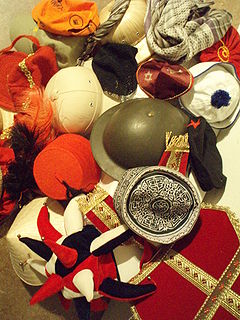
Headgear, headwear or headdress is the name given to any element of clothing which is worn on one's head.

The poffer, toer or North Brabantian hat is a traditional female folk headdress of North Brabant, most famous of the Meierij of 's-Hertogenbosch and of northern Limburg, Netherlands. The poffer was worn only by married women. It was fashionable between the 1860s and the 1920s. In contrast to Zeeland and the more northern parts of the Netherlands, in North Brabant and Limburg there was never any distinctive folkloric costume worn by either men or women, making the poffer the only folkloric garment in this part of the Netherlands.
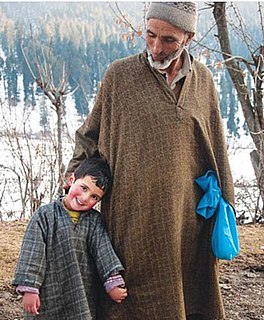
Pheran or phiran is the traditional outfit for both males and females in the Kashmir Valley. The pheran consist of two gowns, one over the other. The traditional pheran extends to the feet, which was popular up to the late 19th century C.E. However, a relatively modern variation of the pheran extends to below the knees, which is worn with a suthan inside similar to the styles worn in Afghanistan. It is optional to wear the suthan with a long phiran as traditionally lower garments are not worn with pherans. The traditional pheran do not have side slits.

History of clothing in the Indian subcontinent can be traced to the Indus Valley Civilization or earlier. Indians have mainly worn clothing made up of locally grown cotton. India was one of the first places where cotton was cultivated and used even as early as 2500 BCE during the Harappan era. The remnants of the ancient Indian clothing can be found in the figurines discovered from the sites near the Indus Valley Civilisation, the rock-cut sculptures, the cave paintings, and human art forms found in temples and monuments. These scriptures view the figures of human wearing clothes which can be wrapped around the body. Taking the instances of the sari to that of turban and the dhoti, the traditional Indian wears were mostly tied around the body in various ways.

The keffiyeh or kufiya also known in Arabic as a ghutrah (غُترَة), shemagh, ḥaṭṭah (حَطَّة), and in Persian as a chafiyeh (چفیه), is a traditional Arabian headdress.
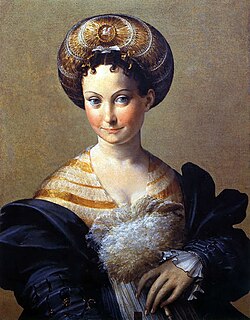
The Balzo was a headdress worn by noblewomen of Italy in the 1530s. It was donut-shaped but appeared turban-like from the front, though it was generally worn further back from the forehead exposing the hair, unlike a period turban.

Kimeshek or Elechek is a traditional headgear of married women with children in Kazakhstan, Karakalpakstan and Kyrgyzstan. Kimeshek is also worn by Central Asian Jewish women. Uzbek and Tajik women wear a similar headdress called lachak. Kimeshek is made of white cloth, and the edge is full of patterns. Kimeshek might have different designs and colors based on the wearer's social status, age, and family.

The makuṭa, variously known in several languages as makuta, mahkota, magaik, mokot, mongkut or chada, is a type of headdress used as crowns in the Southeast Asian monarchies of today's Cambodia and Thailand, and historically in Java and Bali (Indonesia), Malaysia, Laos and Myanmar. They are also used in classical court dances in Cambodia, Indonesia, Malaysia and Thailand; such as khol, khon, the various forms of lakhon, as well as wayang wong dance drama. They feature a tall pointed shape, are made of gold or a substitute, and are usually decorated with gemstones. As a symbol of kingship, they are featured in the royal regalia of both Cambodia and Thailand.
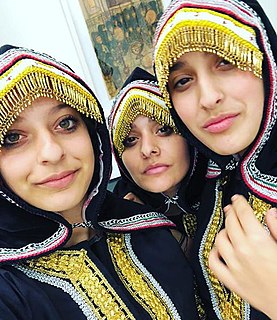
Gargush is a traditional Yemenite Jewish headdress, resembling a hood, which is thought to have originated in the Sanaite community.

Liangbatou (Leeyan-barh-toe) is a hairstyle/headdress worn by Manchu women. It is a tall headdress that features two handfuls of hair, parted to each side of the head, sometimes with the addition of wire frames, extensions and ornamentation.